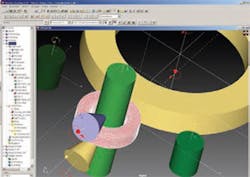In a survey of decision-makers among FORGING readers conducted late last year, representing a nearly complete sample of the North American forging industry, we learned that 52% have adopted simulation software either to plan their forging production processes or to analyze the results of their work. Also impressive is the fact that 15% of all respondents listed new investments in simulation software among their capital improvement plans for 2011.
They are in luck. The year to date has seen some notable new releases from several of the simulation platforms most widely adopted by forgers.
In March, Simufact Engineering GmbH released version 10.0 of its primary simulation software for forging, Simufact.forming. The emphasis in this new release is on improved software components, but it also introduces more than 40 new functions for pre- and post-processing. These include new functionalities for detailed modeling of larger, more complex models. It also includes significantly improved handling capabilities. Specifically, 10.0 optimizes the interaction between hexahedron meshing, parallel processing, and the use of cluster machines.
Of particular interest to forging operations, Simufact.forming 10.0 delivers improved modules for dieload calculation, and its flexible kinematics module improves its simulation of ring rolling and incremental forming processes.
“As with all versions of our software it is also for this version important for us to focus on our users and their needs, regardless if they are experienced users, CAE engineers, practitioners, or designers,” Simufact managing director and technical director Dr. Hendrik Schafstall explained.
This summer Scientific Forming Technologies Corp. is introducing new versions of its DEFORM software, which is used by product designers to analyze metal forming, heat treatment, machining and mechanical joining. DEFORM v10.2 (beta1) and v11.0 (beta) have been released to distributors, and the official release has been announced for this month (subject to internal testing, the developer noted.)
Among the system improvements in DEFORM v10.2 and v11.0 (beta), Scientific Forming lists an upgrade to the datasharing protocol (MPICH2) for better 64-bit performance in PCs with multi-core processing. There is also support for the 64-bit user subroutine in Windows and Linux systems, and improved batch queue stability in Linux.
In terms of simulation capabilities, the new DEFORM release offers shape morphing and parametric design features in its 3D geometry tool, and its 2D-to-3D translation method will handle multi-phase transformation data. The program has a new Patran data file format importer capability, too.
In the v11.0 Beta program (and optional with 10.2 release) users will find dual-frequency induction heating capability, enhanced 3D extrusion simulation, and a mesoscale microstructure/ material model. In addition, there is an integrated 2D-3D machining distortion model, and the 2D torsion mode now supports elastic-plastic materials.
As these updates, and others, make clear, simulation software is growing more sophisticated in its functionality thanks to the accumulated experience of real-time users as well as the progress of computer science: the advent of multicore processing is just one example of a development with significant practical advantages to users. But, the frequency of product updates is what makes forging processing more sophisticated in real time.
